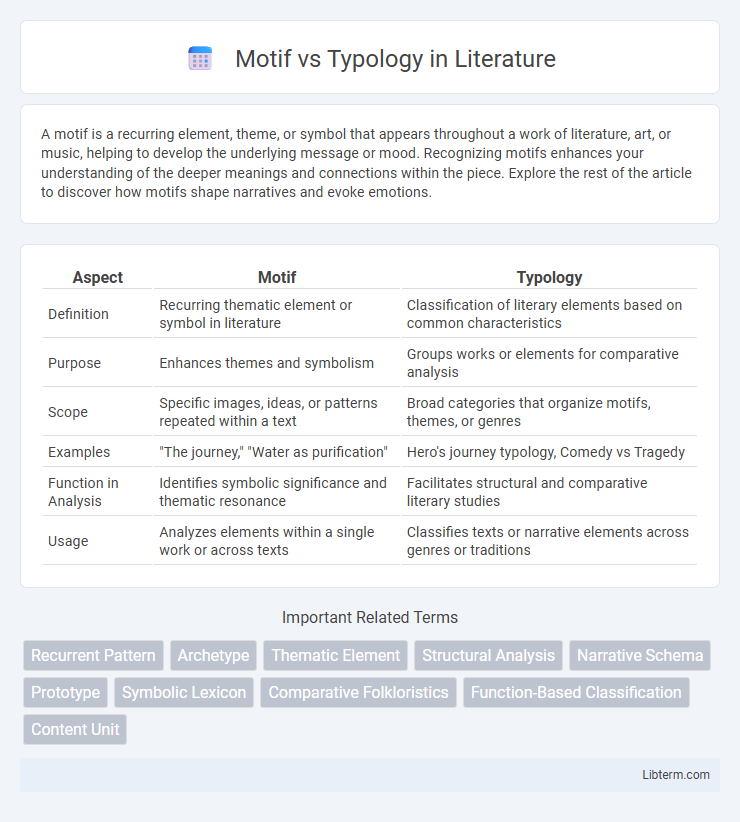A motif is a recurring element, theme, or symbol that appears throughout a work of literature, art, or music, helping to develop the underlying message or mood. Recognizing motifs enhances your understanding of the deeper meanings and connections within the piece. Explore the rest of the article to discover how motifs shape narratives and evoke emotions.
Table of Comparison
| Aspect | Motif | Typology |
|---|---|---|
| Definition | Recurring thematic element or symbol in literature | Classification of literary elements based on common characteristics |
| Purpose | Enhances themes and symbolism | Groups works or elements for comparative analysis |
| Scope | Specific images, ideas, or patterns repeated within a text | Broad categories that organize motifs, themes, or genres |
| Examples | "The journey," "Water as purification" | Hero's journey typology, Comedy vs Tragedy |
| Function in Analysis | Identifies symbolic significance and thematic resonance | Facilitates structural and comparative literary studies |
| Usage | Analyzes elements within a single work or across texts | Classifies texts or narrative elements across genres or traditions |
Introduction to Motif and Typology
Motif in literature refers to a recurring element, such as a symbol, theme, or idea, that reinforces the overall narrative and adds depth to the story. Typology, derived from literary criticism and biblical studies, involves interpreting characters, events, or symbols as prefigurations or patterns that correspond to later developments or meanings. Both motif and typology serve as analytical tools to uncover layered meanings, with motifs emphasizing repetition and typology focusing on relational patterns across texts.
Defining Motif in Literature and Art
A motif in literature and art refers to a recurring element, theme, symbol, or idea that holds symbolic significance throughout a work, contributing to its overall meaning or mood. Motifs can be objects, sounds, phrases, or colors that reinforce the central themes and help establish a pattern that enhances narrative or artistic coherence. Distinct from typology, which categorizes based on broader patterns or classifications, motifs emphasize repetition of specific details that evoke emotional or intellectual responses.
Understanding Typology: Concepts and Applications
Typology is a systematic classification approach that organizes literary or cultural elements based on recurring themes, structures, or patterns, distinguishing it from motifs which are single recurring images or ideas. It enables researchers to analyze broader narrative frameworks by grouping similar types of characters, events, or symbols across texts, facilitating comparative studies and thematic exploration. Practical applications of typology include tracking cultural diffusion, understanding genre evolution, and interpreting symbolic meanings within various historical or literary contexts.
Key Differences Between Motif and Typology
Motif refers to a recurring element, theme, or concept in literature, art, or culture that carries symbolic meaning, while typology involves the classification of these elements based on shared characteristics or patterns. Motifs are specific and repeated narrative devices or images, whereas typology categorizes broader groups or types within a system, such as character archetypes or thematic classes. The key difference lies in motif being a single thematic unit, whereas typology organizes these units into systematic categories for analysis.
Common Examples of Motifs
Common examples of motifs in literature include the journey symbolizing personal growth, darkness representing ignorance or evil, and water portraying cleansing or rebirth. Unlike typology, which draws parallels between characters or events across texts, motifs are recurring thematic elements that reinforce a story's central message. Motifs often appear as images, phrases, or symbols, such as the use of light to symbolize knowledge or the seasons reflecting life cycles.
Notable Examples of Typology
Typology in literature categorizes recurring narrative patterns based on underlying themes such as the hero's journey, creation myths, and apocalypse stories, exemplified by the archetypal "Odyssey" and "The Divine Comedy." Unlike motifs, which are specific recurring symbols or images like shadows or mirrors, typologies encompass broader story structures and character roles found across cultures. Notable examples of typology include the "Trickster" figure present in Native American and African folklore and the "Rags to Riches" storyline common in fairy tales worldwide.
Role of Motif in Storytelling
Motifs serve as recurring elements or symbols that reinforce the central themes and emotional undertones of a story, creating cohesion and deeper meaning throughout the narrative. Unlike typology, which categorizes characters or events based on archetypal patterns, motifs subtly enhance storytelling by highlighting significant ideas and guiding audience interpretation. Their strategic repetition helps to establish mood, foreshadow plot developments, and enrich character arcs within diverse literary and cinematic works.
Typology in Cultural and Historical Analysis
Typology in cultural and historical analysis involves categorizing artifacts, texts, or social phenomena based on shared characteristics to identify patterns in human behavior and societal development. Unlike motifs, which are recurring narrative elements or symbols, typology provides a systematic framework for comparing cultural expressions across different societies and time periods. This method enables researchers to trace cultural evolution, diffusion, and interaction by organizing data into archetypes that reveal underlying structural similarities.
How Motif and Typology Interact
Motif and typology interact by shaping narrative structures through recurring themes and classification systems that define cultural and literary patterns. Motifs provide the detailed, repeated elements within stories, while typology offers broader categories that organize these motifs into coherent frameworks for analysis. Their interaction enhances understanding of cultural transmission by linking specific symbolic content (motifs) to systematic patterns (typologies) across different traditions.
Conclusion: Choosing Between Motif and Typology
Choosing between motif and typology depends on the research objective and analytical scope within folklore and literary studies. Motif analysis offers granular insight into recurring narrative elements, ideal for detailed thematic exploration, while typology categorizes broader narrative patterns, aiding in structural comparison across cultures. Effective selection aligns method with study goals, ensuring nuanced interpretation or comprehensive classification of narratives.
Motif Infographic

 libterm.com
libterm.com